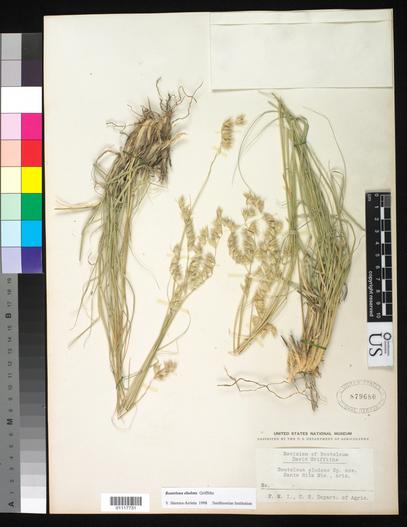Santa Rita Mountain Grama
(Bouteloua eludens)
Santa Rita Mountain Grama (Bouteloua eludens)
/
/

National Museum of Natural History
CC0
Image By:
National Museum of Natural History
Recorded By:
Copyright:
CC0
Copyright Notice:
Photo by: National Museum of Natural History | License Type: CC0 | License URL: http://creativecommons.org/publicdomain/zero/1.0/deed.en | Uploader: Fuzheado | Publisher: Wikipedia Commons








Estimated Native Range
Summary
Bouteloua eludens, commonly known as Santa Rita Mountain Grama, is a deciduous perennial grass that is native to the semi-arid grasslands and desert scrublands of the Southwestern United States and Northwestern Mexico. It is adapted to open spaces where it can receive full sunlight. Santa Rita Mountain Grama typically grows between 25 cm (9.8 in) and 70 cm (28 in) tall, with grass blades that are 1 mm (0.039 in) to 2.5 mm (0.098 in) wide. The blades are flat, firm, and light green, with a distinctive glaucous coating that helps reflect sunlight and conserve water. The plant forms a rhizome-like base, which contributes to its ability to spread and fill in areas as a ground cover. Its inflorescences are showy, with colors ranging from purple to brown, and are borne in groups of 8 to 18, adding a unique texture to the landscape during their bloom period.
Santa Rita Mountain Grama is valued for its drought tolerance and ability to thrive in poor soils, making it an excellent choice for xeriscaping and naturalistic plantings in arid regions. It is often used for erosion control, as a turf substitute in low-traffic areas, and for restoration projects where native grasses are preferred. This grass requires minimal maintenance once established and is best suited to full sun conditions with low to medium water requirements. It prefers well-drained soils and can tolerate a range of soil types, from sandy to loamy. While generally disease-free, overwatering or poor drainage can lead to root rot.CC BY-SA 4.0
Santa Rita Mountain Grama is valued for its drought tolerance and ability to thrive in poor soils, making it an excellent choice for xeriscaping and naturalistic plantings in arid regions. It is often used for erosion control, as a turf substitute in low-traffic areas, and for restoration projects where native grasses are preferred. This grass requires minimal maintenance once established and is best suited to full sun conditions with low to medium water requirements. It prefers well-drained soils and can tolerate a range of soil types, from sandy to loamy. While generally disease-free, overwatering or poor drainage can lead to root rot.CC BY-SA 4.0
Plant Description
- Plant Type: Grass
- Height: 3-6 feet
- Width: 2-5 feet
- Growth Rate: Moderate
- Flower Color: N/A
- Flowering Season: Summer
- Leaf Retention: Deciduous
Growth Requirements
- Sun: Full Sun
- Water: Low, Medium
- Drainage: Medium, Fast
Common Uses
Bird Garden, Drought Tolerant, Groundcover, Low Maintenance
Natural Habitat
Native to semi-arid grasslands and desert scrublands
Other Names
Common Names: Santa Rita Grama
Scientific Names: , Bouteloua eludens,
GBIF Accepted Name: Bouteloua eludens Griffiths